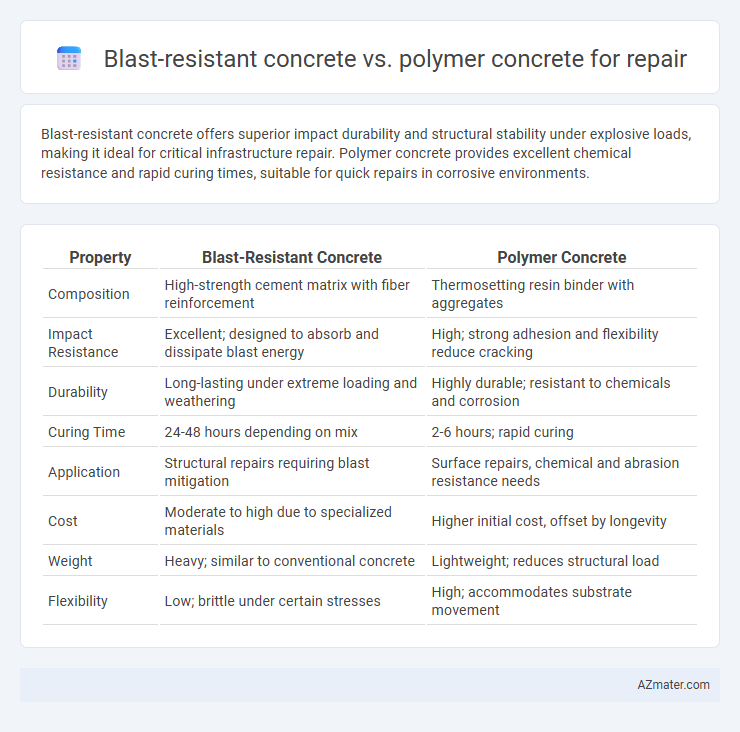Blast-resistant concrete offers superior impact durability and structural stability under explosive loads, making it ideal for critical infrastructure repair. Polymer concrete provides excellent chemical resistance and rapid curing times, suitable for quick repairs in corrosive environments.
Table of Comparison
| Property | Blast-Resistant Concrete | Polymer Concrete |
|---|---|---|
| Composition | High-strength cement matrix with fiber reinforcement | Thermosetting resin binder with aggregates |
| Impact Resistance | Excellent; designed to absorb and dissipate blast energy | High; strong adhesion and flexibility reduce cracking |
| Durability | Long-lasting under extreme loading and weathering | Highly durable; resistant to chemicals and corrosion |
| Curing Time | 24-48 hours depending on mix | 2-6 hours; rapid curing |
| Application | Structural repairs requiring blast mitigation | Surface repairs, chemical and abrasion resistance needs |
| Cost | Moderate to high due to specialized materials | Higher initial cost, offset by longevity |
| Weight | Heavy; similar to conventional concrete | Lightweight; reduces structural load |
| Flexibility | Low; brittle under certain stresses | High; accommodates substrate movement |
Introduction to Blast-Resistant and Polymer Concrete
Blast-resistant concrete is engineered with enhanced toughness and energy absorption characteristics to withstand high-impact explosions and mitigate structural damage. Polymer concrete utilizes polymer resins as a binder instead of traditional cement, providing superior chemical resistance, rapid curing, and strong adhesion for durable repairs. Both materials offer specialized solutions for structural reinforcement and repair, with blast-resistant concrete focusing on impact resilience and polymer concrete emphasizing versatility and durability in harsh environments.
Key Properties of Blast-Resistant Concrete
Blast-resistant concrete features high compressive strength, energy absorption, and enhanced toughness to withstand explosive impacts, making it ideal for structural repairs in high-risk environments. Its dense matrix and specialized aggregate composition reduce spalling and prevent catastrophic failure under blast loads. Compared to polymer concrete, blast-resistant concrete offers superior durability and resistance to extreme dynamic stresses, ensuring long-term integrity in protective repair applications.
Defining Polymer Concrete for Repairs
Polymer concrete is a composite material composed of a polymer binder and aggregate, offering superior adhesion, chemical resistance, and fast curing times compared to traditional cement-based materials. It is specifically designed for repair applications where durability and resistance to harsh environments, including blast impacts and chemical exposure, are critical. Unlike blast-resistant concrete, polymer concrete provides enhanced flexibility and shrinkage control, making it ideal for precise structural repairs and rehabilitation of damaged infrastructure.
Comparative Strength and Durability
Blast-resistant concrete exhibits superior compressive strength and impact resistance due to its dense composition and reinforced aggregates, making it highly effective in withstanding explosive forces. Polymer concrete, while offering enhanced chemical resistance and flexibility, generally has lower impact strength but excels in durability against corrosion and environmental degradation. Comparative assessments show blast-resistant concrete is preferable for high-impact repair scenarios, whereas polymer concrete is ideal for environments requiring long-term chemical stability.
Blast Resistance Performance Analysis
Blast-resistant concrete demonstrates superior energy absorption and structural integrity under high-impact explosions compared to polymer concrete, which typically offers enhanced chemical resistance but lower blast tolerance. Studies reveal that blast-resistant concrete formulations incorporate dense aggregates and fiber reinforcement to dissipate shock waves effectively, minimizing spall and cracking during blast events. Polymer concrete, while advantageous in corrosive environments, often lacks the compressive strength and fracture toughness necessary to withstand intense blast loads, making blast-resistant concrete the preferred choice for critical infrastructure repair subjected to explosive forces.
Repair Efficiency and Application Methods
Blast-resistant concrete offers superior durability and impact resistance, making it ideal for structural repairs in high-risk areas, with application methods often involving high-pressure spraying or formwork casting for precise reinforcement. Polymer concrete excels in chemical resistance and rapid curing times, enabling efficient repairs in environments exposed to corrosive substances, typically applied through mixing and pouring or troweling techniques for seamless integration. Repair efficiency favors blast-resistant concrete in heavy-duty scenarios, while polymer concrete provides versatile, quick-setting solutions for less impact-intensive but chemically aggressive conditions.
Cost-Benefit Analysis of Material Choices
Blast-resistant concrete offers superior durability and impact resistance, making it ideal for high-risk infrastructure repairs, but typically incurs higher upfront costs due to specialized aggregates and additives. Polymer concrete provides enhanced chemical resistance and faster curing times, which can reduce labor expenses and downtime, offering a cost-effective solution for smaller-scale or less-impact-critical repairs. Evaluating the specific project requirements and long-term maintenance savings is essential to determine the best cost-benefit balance between blast-resistant and polymer concrete materials.
Environmental and Safety Considerations
Blast-resistant concrete offers enhanced durability and high compressive strength, making it ideal for critical infrastructure but involves energy-intensive manufacturing processes that contribute to a larger carbon footprint. Polymer concrete provides superior chemical resistance and faster curing times, reducing on-site hazards and emissions during repair, while its synthetic resin components may raise concerns about long-term environmental impact and toxicity. Choosing between these materials for repair applications requires balancing blast protection performance with sustainability goals and occupational safety standards.
Case Studies in Concrete Repair
Case studies in concrete repair reveal that blast-resistant concrete demonstrates superior performance under high-impact conditions due to its enhanced energy absorption and crack resistance, making it ideal for military and infrastructure applications. Polymer concrete, favored in rapid repair scenarios, offers excellent adhesion, chemical resistance, and reduced curing times, which are critical in maintaining structural integrity with minimal downtime. Comparative analyses highlight that while blast-resistant concrete excels in durability against explosive forces, polymer concrete provides flexibility and durability in corrosive environments, driving targeted repair strategies based on specific site demands.
Choosing the Right Material for Structural Resilience
Blast-resistant concrete offers superior impact absorption and energy dissipation, making it ideal for critical infrastructure requiring high structural resilience. Polymer concrete provides enhanced chemical resistance and rapid curing times, suited for repairs in aggressive environments. Selecting the right material depends on the specific repair conditions, balancing blast load demands with environmental exposure.

Infographic: Blast-resistant concrete vs Polymer concrete for Repair
 azmater.com
azmater.com